I am Locutus of Borg. Resistance is futile. Your life, as it has been is over. From this time forward, you will service us.Locutus of Borg
The real Borg are still out there, and they have a name for you: Locutus of Borg. The only Borg so deadly they gave him a goddamn name.Liam Shaw
"Locutus of Borg" was the Borg designation forced upon Starfleet captain Jean-Luc Picard after his assimilation in late 2366.
History
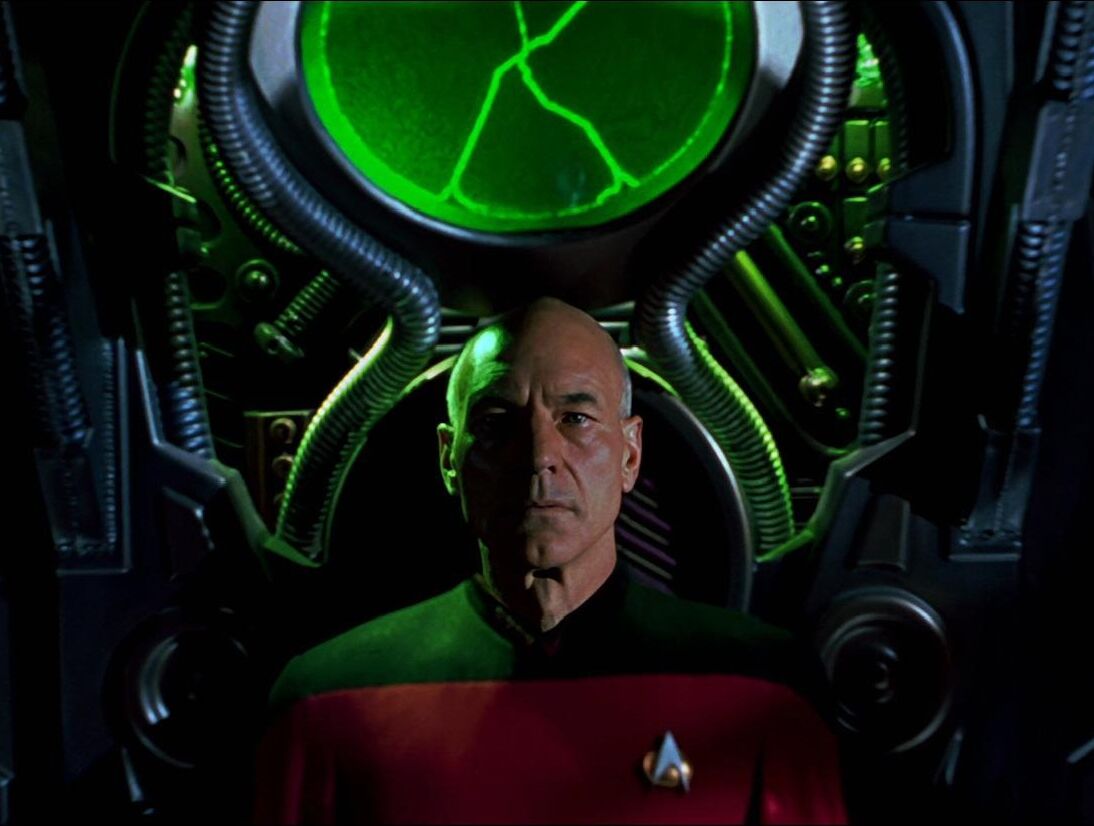
The Borg intended to use Picard as an intermediary, a spokesman for the Human race, in order to facilitate the assimilation of Earth so that the process would be as quick and efficient (or as perfect, from the perspective of the Borg Collective) as possible, with the fewest number of casualties on both sides. He may have had some form of individuality, as shown by his use of the pronoun "I". (TNG: "The Best of Both Worlds")
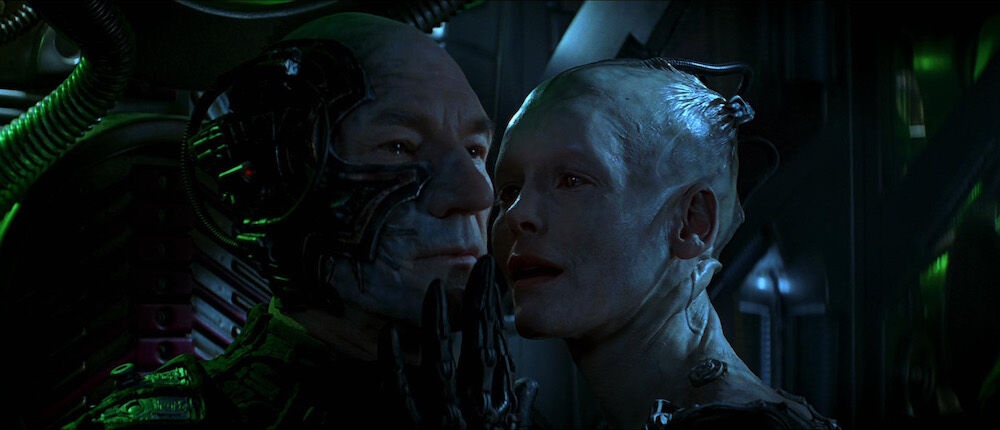
The Borg Queen herself had been aboard the Borg cube where Picard had undergone his transformation into Locutus. Interested in overseeing this event, she had intended for Picard to become her equal counterpart. (Star Trek: First Contact)
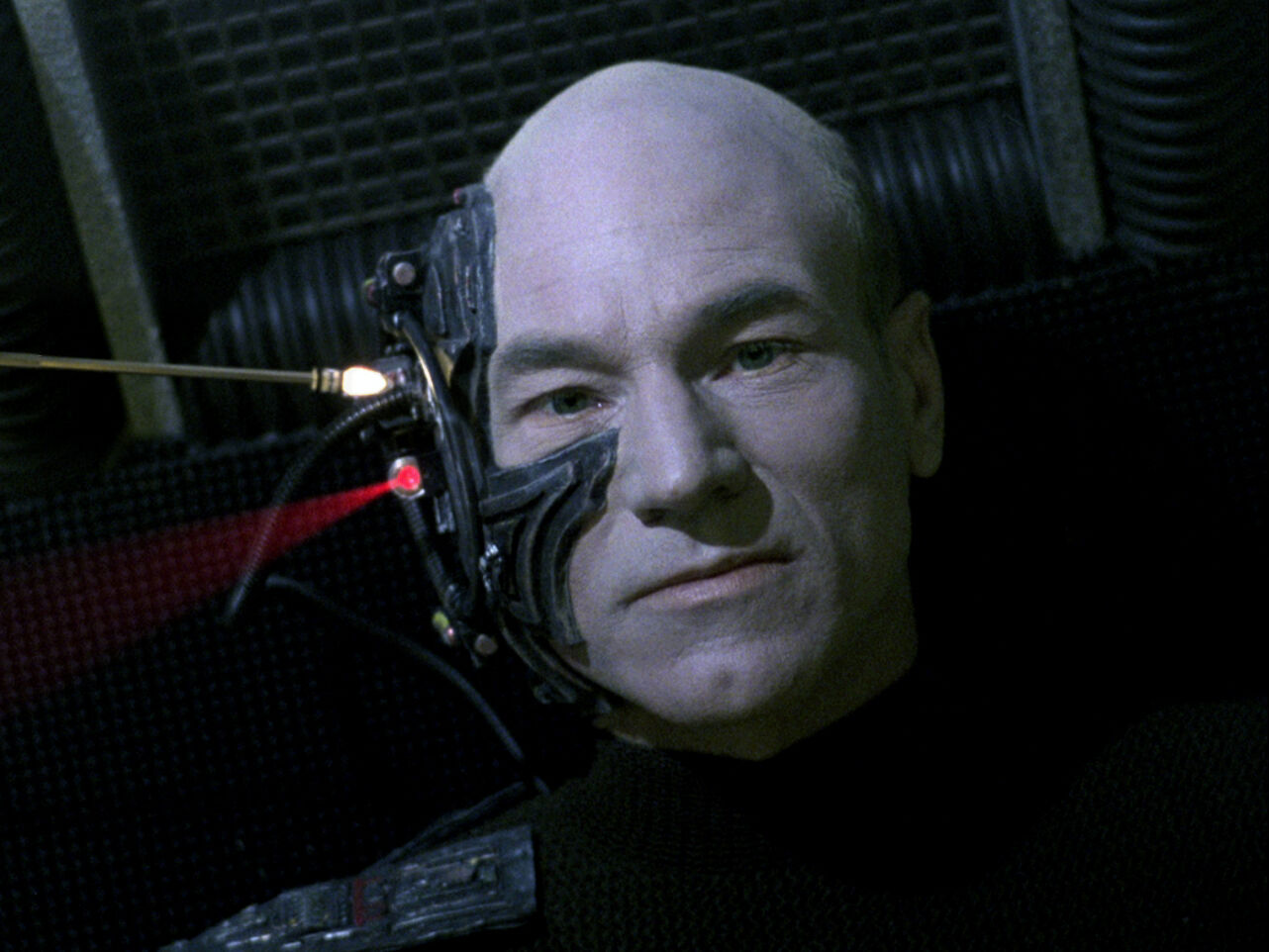
Picard's assimilation allowed the Borg to acquire the whole of his knowledge and experience, as well as his own personal knowledge (a fact that was made apparent when Locutus addressed Commander Riker as "Number one"). Picard's detailed information regarding Federation technology and strategy yielded the Borg a significant tactical advantage when Starfleet confronted the Borg cube at Wolf 359. (TNG: "The Best of Both Worlds, Part II"; DS9: "Emissary")
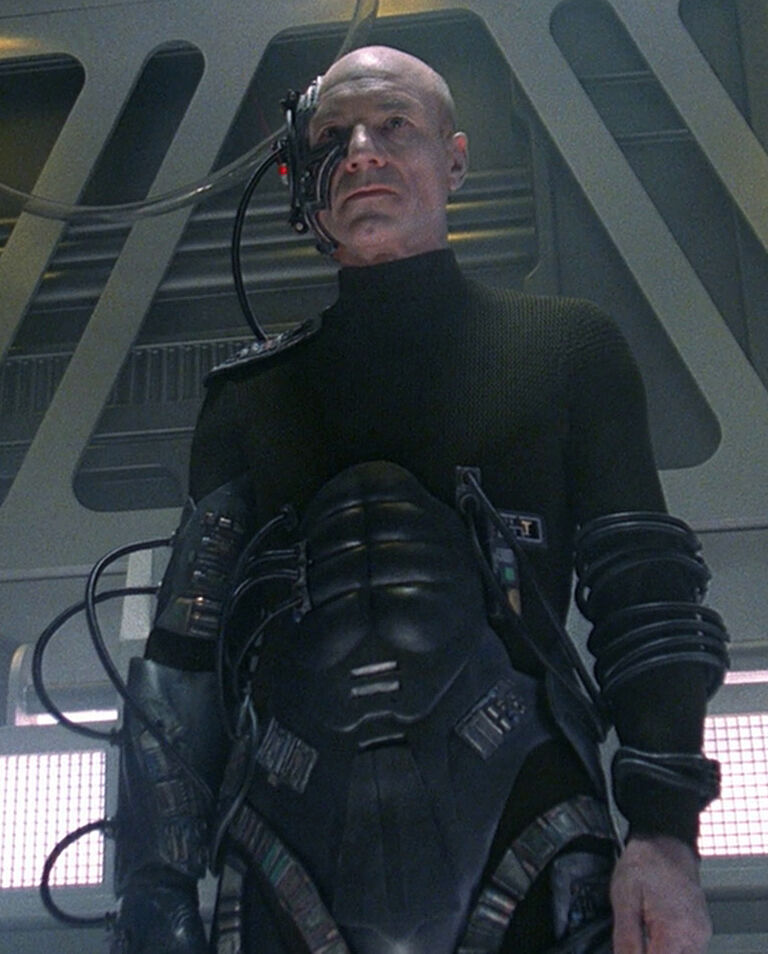
This access proved two-way, however, as the crew of the USS Enterprise-D was able to capture Locutus and use his link to disable and destroy the Borg vessel by sending the Borg cube a command to regenerate, which created a feedback loop that destroyed the cube and severed Picard's link to the Collective. (TNG: "The Best of Both Worlds, Part II")
Legacy
Though his implants were removed and his wounds were allowed to heal, Picard's assimilation continued to haunt him. He returned to Earth, and paid a visit to his family in La Barre, France, where he eventually came to terms with the ordeal. (TNG: "Family")
Despite this, he carried the trauma for years, with it nearly overwhelming him when he visited the Artifact. (PIC: "The Impossible Box")
Despite his separation from the Collective, Borg drones that had never encountered Locutus, such as Third of Five, still referred to Picard using this name, due to Locutus' experiences remaining within the shared Hive mind. (TNG: "I Borg", "Descent")
When Benjamin Sisko made contact with the Prophets in 2369, one took the form of Locutus as he appeared on the viewscreen of Sisko's ship, the USS Saratoga, shortly before the Battle of Wolf 359. (DS9: "Emissary")
When the Borg attempted a second invasion in 2373, Picard's experience with the Borg not only gave him prior warning of the attack, but also allowed him to pinpoint a weakness in the Borg defenses, which resulted in the fleet destroying the invading vessel. In the process, Picard displayed a residual link to the Collective even without Locutus' implants. (Star Trek: First Contact)
In 2374, when Captain Kathryn Janeway was conducting negotiations with the Borg during the Borg-Species 8472 War, she requested to speak to an individual, and cited to the Borg: "You've done it before, when you transformed Jean-Luc Picard into Locutus." The Borg ultimately complied by sending Seven of Nine to Janeway. (VOY: "Scorpion, Part II")
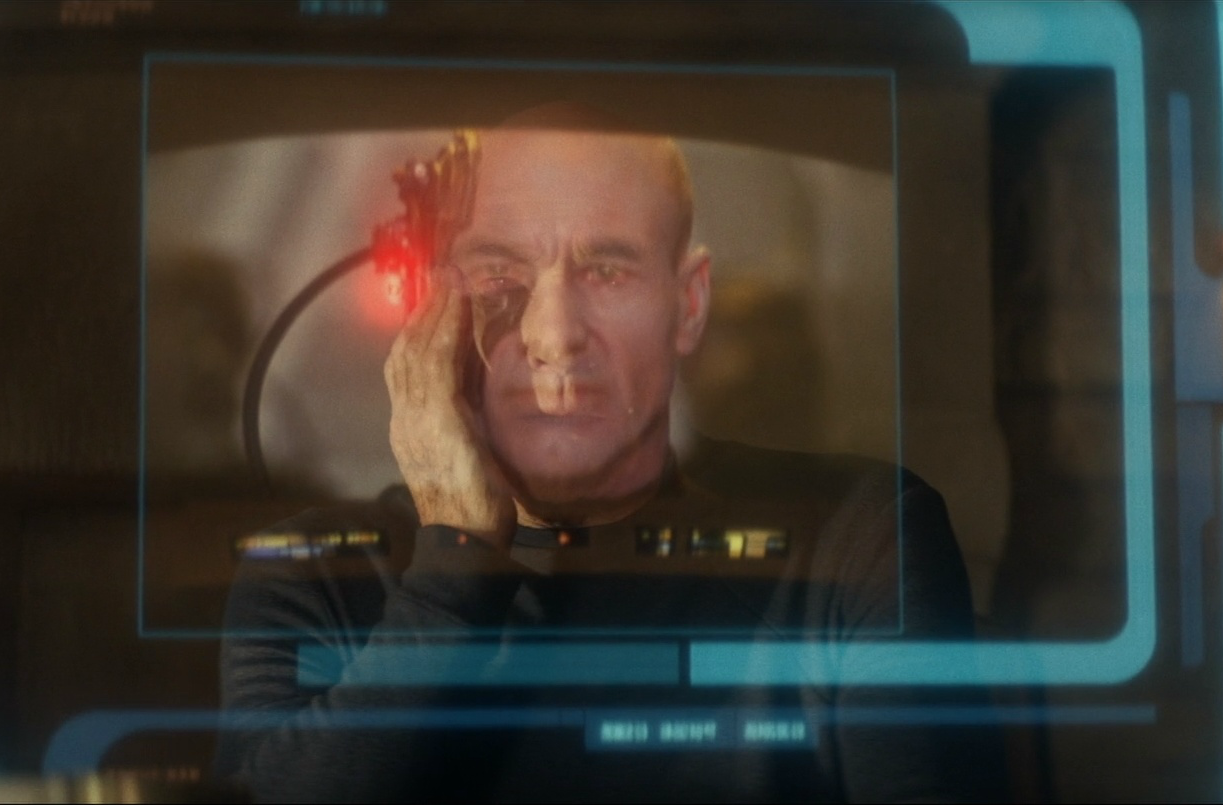
When Picard went to the Artifact in 2399, looking to find Soji Asha, he ran a computer search. One of the images that came up was of Locutus, which Picard reacted to by placing his hand on his own face, where the Borg implants had once been. Once he reached the Artifact, Picard began to experience anxiety from seeing the Borg architecture, thus experiencing vivid memories of his time as Locutus, recalling individuals such as the Borg Queen. He almost fell over until he was aided by several former drones. Hugh, who had accompanied the former drones then reassured Picard that he was no longer Locutus. Nevertheless, one of the former drones there later recognized him as such, (PIC: "The Impossible Box") as did the Borg Queen in the Confederation of Earth timeline. (PIC: "Penance", "Assimilation")
In 2401, it was discovered that what was believed to have been Irumodic Syndrome and a defect in Picard's brain was actually a result of genetic alterations that the Borg made while Picard was Locutus of Borg, alterations that went beyond even what a normal Borg drone received. These alterations made Picard a receiver for the Borg Collective, resulting in Picard maintaining a residual link with the Borg even without Locutus' implants. This alteration was also inherited by Picard's son Jack Crusher, although he became a transmitter rather than a receiver. By taking Picard's Borg-altered DNA and placing it into the transporter systems of Starfleet, the Changelings were able to compromise Starfleet, allowing the Borg to begin a takeover of the Federation from the inside. (PIC: "Võx")
After reuniting with Picard on a Borg cube over Jupiter, the Borg Queen referred to Picard as Locutus, but was no longer interested in returning Picard to Locutus as she now sought to make the Borg evolve, propagate and wipe out all other lifeforms in the galaxy. When Picard linked back into the Collective in an effort to save Jack, he experienced the same flashbacks of himself as Locutus that he had once seen just prior to the Battle of Sector 001. (PIC: "The Last Generation")
Appendices
Appearances
- TNG:
- DS9: "Emissary"
- Star Trek: First Contact
- PIC:
- "The Impossible Box" (archive footage)
- "No Win Scenario" (archive footage)
- "The Last Generation" (archive footage)
Background information
Conception
The character of Locutus was created as a result of the writing staff of Star Trek: The Next Generation feeling it necessary for the Borg to have a spokesman, which the writing staffers referred to as a "queen bee." (Captains' Logs: The Unauthorized Complete Trek Voyages) Another inspiration on the character's creation, according to writer Michael Piller, was that the writing staff was requested by Paramount to devise a method of potentially writing Picard actor Patrick Stewart out of the series after the third season. This was because Paramount was having negotiating difficulties regarding closing a deal with Stewart that would see him return for the fourth season. (Star Trek: The Magazine Volume 1, Issue 23, p. 16)
The concept of using Picard to fill the persona of the Borg's central voice was directly preceded by a notion that involved the Borg capturing both him and Data before combining them as a single entity. (Star Trek: The Magazine Volume 1, Issue 23, p. 16; Captains' Logs: The Unauthorized Complete Trek Voyages) Michael Piller pitched this initial concept to Rick Berman. (Star Trek: The Magazine Volume 1, Issue 23, p. 16) However, the idea was dropped when it was realized that the Borg lacked sufficient motive to carry out these actions. (Captains' Logs: The Unauthorized Complete Trek Voyages) Berman felt the suggestion of the assimilated Picard and Data combo was overly complicated. (Star Trek: The Magazine Volume 1, Issue 23, p. 16)
According to the reference book Captains' Logs: The Unauthorized Complete Trek Voyages, it was Michael Piller himself who came up with the subsequent idea of filling the spokesman role with an assimilated Picard, alone, and the writer later remembered, "It all just fell into place. I said, 'I've got it. Picard will be the queen bee.'" Alternatively, according to Star Trek: The Magazine Volume 1, Issue 23 (p. 16), Piller cited Rick Berman as having made the suggestion, though admitted, "I thought that making Picard that voice would be interesting."
The concept of Locutus was foremost on Michael Piller's mind in the lead-up to writing "The Best of Both Worlds". Thus, after Piller decided he wanted to write the episode, one of the first ideas that he privately disclosed to fellow TNG writing staffer Ira Steven Behr was that of Picard being assimilated by the Borg. (Star Trek: The Next Generation 365, p. 163)
As for the name Locutus, Michael Piller termed it as "a name which I got out of the dictionary about language – I think it's a Latin word for language." (Star Trek: The Magazine Volume 1, Issue 23, p. 17) Locūtus actually means "having spoken" or "he who has spoken" in Latin, still an appropriate name for one serving as spokesman, although idiosyncratic. (In Latin, there are two similar words Locūtor meaning "speaker" or "spokesman"; and Locūtio means "speech", or at a stretch, the "language" definition, as suggested by Piller.)
The final draft script for "The Best of Both Worlds" stipulates about the assimilated Picard, "Half his face is gone… replaced with machinery." A later description from the same script refers to Locutus as "Picard-Borg" and further states, "He speaks with a single but metallic Borg voice… a version of his [Picard's] own." [1]
The way in which Locutus was represented in "The Best of Both Worlds" turned out to be very successful with production staff. David Livingston remarked, "I just remember the moment in dailies of seeing Patrick say, 'You will be assimilated' […] I think that was the turning point for the series, because here you have your captain, who's now a Borg, who's saying he's now gonna take you guys over. That was an extraordinary moment." Livingston noted that the image of Locutus was an expression of the central concept of the Borg – the risk that Humans might lose their individuality and Humanity. (Regeneration: Engaging the Borg, "The Best of Both Worlds" (Blu-ray) The way in which Michael Piller single-handedly delivered the concept of Locutus in the writing of "The Best of Both Worlds" impressed Ira Steven Behr, who later commented, "By Borgifying Picard, Michael tapped into Picard's Humanity. Because at the time, the fans were bitching about Picard [such as by complaining that he was 'too cold' or not similar enough to Kirk] […] But by Borgifying Picard – which is something that Michael really related to, because there was a little bit of Borg in him – it led the way to 'Family,' and […] it's what kept the franchise alive." (Star Trek: The Next Generation 365, p. 163)
Jonathan Frakes had several suspicions regarding how effective Locutus was with fans. "I'm not sure that anybody really believed Patrick was leaving the show," admitted Frakes. "But I believed that the drama […] and the vision of him as Locutus, a Borg, was strong enough that you could suspend your disbelief in a way that, 'Oh, my…' And it really did get you through the summer." (Regeneration: Engaging the Borg, "The Best of Both Worlds" (Blu-ray))
Following the initial airing of "The Best of Both Worlds", fans anticipated discovering Picard's fate so much that someone devised a hoax script supposedly of the concluding part of the story, in which it turned out that Picard's assimilation had actually been a prank by the Q Continuum. ("The Best of Both Worlds, Part II" text commentary, Star Trek: Borg - Fan Collective)
For help with wording the process of corrupting the Locutus persona in order to enable Picard's inevitable return in "The Best of Both Worlds, Part II", visual effects artists including Rick Sternbach were consulted. "We sat down with Michael Piller and a couple of the other writers," recollected Sternbach, "and presented some of our notes about Data, and Picard as Locutus and, technically, how to get Picard back when shutting down the Borg collective mind and that sort of thing." (Regeneration: Engaging the Borg, "The Best of Both Worlds" (Blu-ray))
Televised depictions
Locutus was a larger role than Patrick Stewart was used to playing on TNG. "This part gave Patrick the chance to fish-out-of-water character. You know, to not just have that one dimension that he had on the series," observed Director Cliff Bole. "This gave him another chance to be a heavy, which is always great fun for an actor. He enjoyed it, tremendously." ("Regeneration: Engaging the Borg", "The Best of Both Worlds" (Blu-ray)) Indeed, despite the increased workload, Stewart found that playing Locutus was an interesting experience without being overly taxing. He explained, "The interesting situation for me was how to create this murderous, autonomous figure while retaining, behind all that, the shadow of Jean-Luc [....] I think, for me, the Borg episodes were not as dramatic as they were for our audience. I can think of other episodes in which I felt that the character was expanding, developing and learning much more than in that one. It principally for me was a way of trying to find out how technically to make the Borg character work. Of course, a lot of it was left to the makeup department and the special effects department. The makeup made a significant contribution." (Star Trek: The Official Fan Club Magazine issue 87, p. 4)
Concerning the "Best of Both Worlds" two-parter, Marina Sirtis asked, "Was that the one we got to see Patrick naked?" Although nudity was out-of-the-question for a family TV series such as TNG, Locutus had to be made to look differently from Picard. Stated Makeup Supervisor Michael Westmore, "We had to more or less take him through steps of Borgifying him." ("Regeneration: Engaging the Borg", "The Best of Both Worlds" (Blu-ray)) Depicting the gradual draining of Picard's Humanity as he was transformed from Human into Borg, during the two-parter, represented a challenge for TNG's makeup team. Initially, this was done by showing the exposed areas of his body paler by a couple of shades. According to Westmore, this demonstrated that "as Humanity was drained away so was the color of life." Even when the full Borg makeup of Locutus was applied, the creative team still wanted to leave enough of the Picard character visibly recognizable so that the contrast between the two personalities was startling. (Star Trek: Aliens & Artifacts, p. 85) The amount of bare skin involved in portraying Locutus was influenced by the fact that either Westmore or Rick Berman wanted the Borg drones in the two-parter to exhibit more baldness than in "Q Who". "So when it came down to Patrick," remembered Westmore, "here's a man with a bald head. They didn't want to put a helmet on him." ("Regeneration: Engaging the Borg", "The Best of Both Worlds" (Blu-ray))
In the form it took on television, Locutus' Borg suit was created as a collaboration between Michael Westmore and Costume Designer Robert Blackman. The suit's face plates were crafted by Westmore from life castings of Patrick Stewart. ("The Best of Both Worlds, Part II" text commentary, Star Trek: Borg - Fan Collective) Todd Masters said of the costume, "It had galoshes and phone cords on the feet, and underwear sprinkled with poly-foam and model parts." (Cinefex, No. 69, p. 105) The costume also incorporated a mechanical Borg arm prop which was a slightly modified version of those from "Q Who". (Star Trek: The Magazine Volume 3, Issue 2, p. 15)
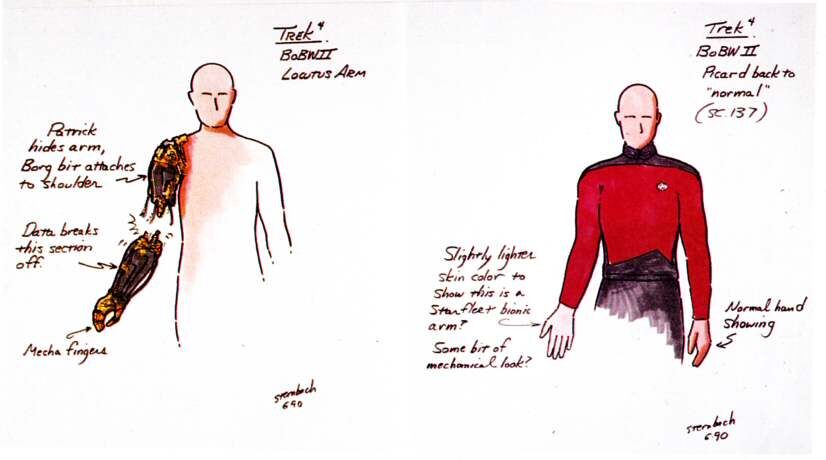
There were actually two main variations of Locutus' full Borg makeup created for television – one that was used at the end of "The Best of Both Worlds", and another that was applied for the start of "The Best of Both Worlds, Part II". Whereas the first of these makeup designs incorporated a headpiece that wrapped round from the back of the head to the front of the face where it covered the right cheek, the second version extended the headpiece so that it covered the majority of the face. Similarly, though the first variant of the makeup included only a few black ribbed tubes that seemed to run into his body and merely one identical tube that ran through the headpiece (a lead which, according to Michael Westmore, was intended "to indicate that it was connected directly through his skull to his brain"), the later version had considerably more tubes. (Star Trek: Aliens & Artifacts, pp. 85 & 87)
Locutus' appearance in Star Trek: Deep Space Nine pilot episode "Emissary" required Patrick Stewart to once again endure the Borg makeup. ("The Best of Both Worlds, Part II" text commentary, Star Trek: Borg - Fan Collective) Michael Piller was extremely proud of having Locutus appear in the opening moments of "Emissary", remarking, "You want to desperately open your show with a bang and what could be a better way to open the show than to have Jean-Luc Picard as Locutus on screen saying, 'You will surrender, resistance is futile.'" (Cinefantastique, Vol. 23, No. 6, p. 34)
The immediate aftermath of Picard's transformation into Locutus was originally planned to be featured in an alternate past timeline experienced by Picard in TNG series finale "All Good Things...". "The idea was when he jumps into that time period he has to convince not only the Borg to help him but Riker to help him," explained Ronald D. Moore. (Cinefantastique, Vol. 25, No. 6/Vol. 26, No. 1, p. 75)
Film appearance
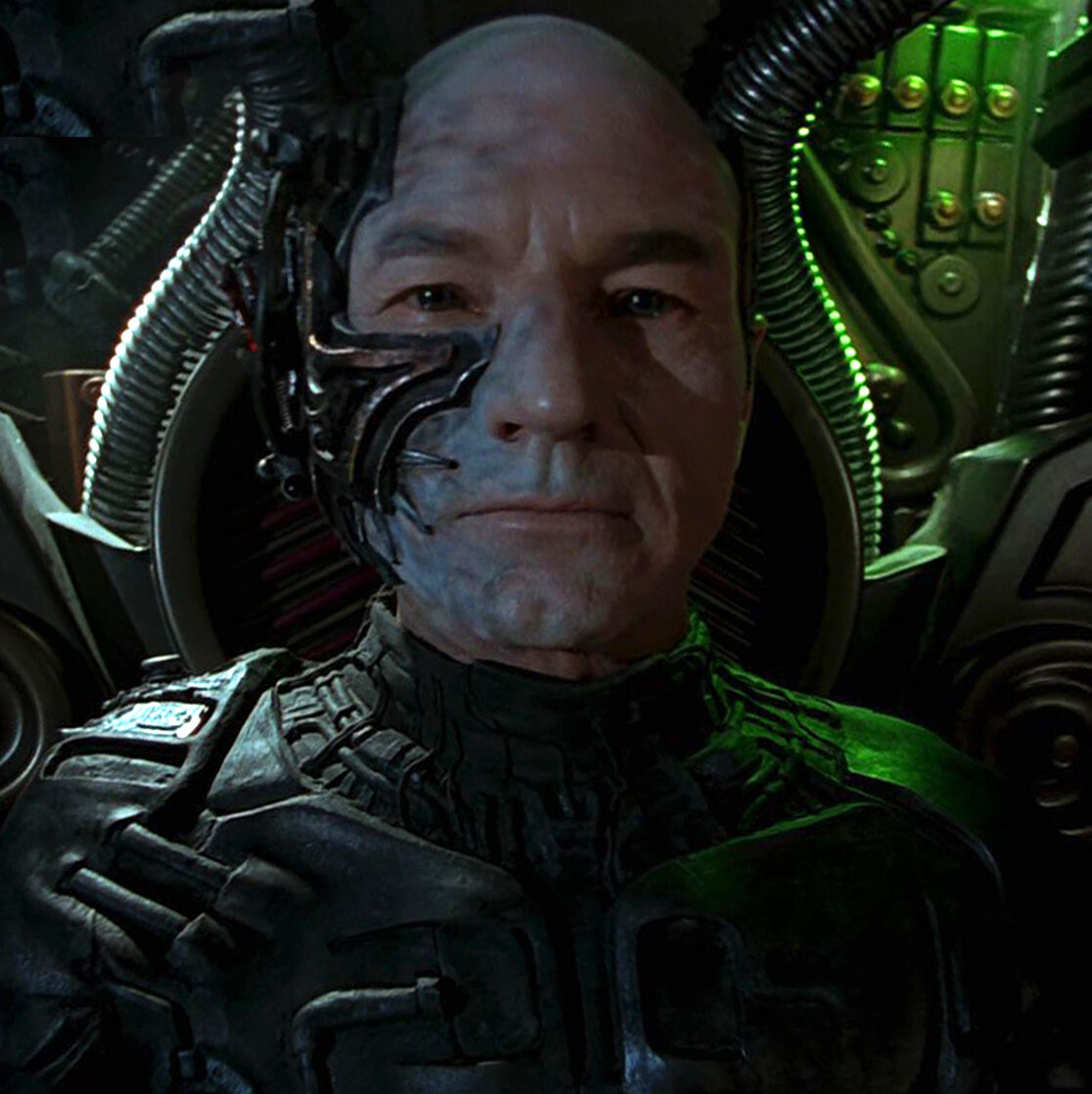
There were noticeable differences in the makeup design of Locutus between the TV series and Star Trek: First Contact. Among the changes seen were airbrushed "wiring" on the skin (made to seem as if it is beneath the skin), slightly more detailed "Borg implants" and a completely new body suit. The changes enhanced the somewhat sparse original look and corresponded with the "new look" of the Borg for the movie. Although creating this physical redesign for Locutus represented a comparatively special challenge for the makeup and costume designers of First Contact, it was not as challenging as it could have been, given that Patrick Stewart was not required to move much or perform stunts while in his Locutus guise. (Cinefantastique, Vol. 28, No. 6, p. 24) The company Todd Masters Effects, hired by Paramount to build all the Borg suits in the film, were originally given the costume that had last been donned by Stewart for "Emissary". "It looked bad," said Masters, "and there was no budget to upgrade it [....] And we knew that the fans would feel cheated if Patrick was wearing this rag while all the other Borg looked great – so we punched it up at our own expense." (Cinefex, No. 69, p. 105)
A specific Locutus-related nightmare sequence from early in First Contact – involving a Borg appliance popping out of Picard's cheek – was planned by Industrial Light & Magic artist Alex Jaeger. He not only drew a concept sketch of the appliance on Picard's cheek, in its fully spread-out state, but also created a computer-generated demonstration of the facial changes. The latter was done using six copies of a promotional head shot of Patrick Stewart as Picard (taken during production on the series) and inserting the slowly evolving "cheek popper" with Photoshop. Jaeger cited an ice-cube holder as inspiration for the dreamt device, "with those fingers that extend and grab." (Star Trek: The Next Generation Sketchbook: The Movies, pp. 332 & 333) The effect was at first conceived as a physical illusion but was ultimately rendered in CGI by Stephen Braggs at ILM. (Cinefex, No. 69, p. 105)
Apocrypha
In the comic story Star Trek: The Next Generation - Perchance to Dream, the Enterprise crew were attacked by a telepathic weapon called the Chova, which forced its victims to experience dreams and hallucinations focused on their personal failures. However, it was discovered that those with Multiple Personality Disorder could render the Chova inert (The multiple personas overwhelming the Chova, which could only attack one personality at the time), so Picard was deliberately infected with the Chova, as his mind meld with Sarek, the probe that gave him the memories of Kamin and the remnants of Locutus still in his mind gave him the makings of an MPD. The four defeated the Chova, but Locutus then attempted to regain control of Picard's body, nearly "killing" Kamin and Sarek before Picard gathered the mental strength to stop Locutus.
In the comic story arc The Worst of Both Worlds!, the Enterprise crew got pulled through a rift into an alternate universe in which Riker's plan to rescue Picard from the Borg failed and the Borg had conquered Earth. The crew team up with their counterparts, whose Enterprise was only the stardrive section, as their saucer section had to be abandoned. The two crews managed to capture Locutus and use his link to the Collective to defeat the Borg, much like in the canon universe, except the "sleep" command couldn't be used. Picard gambled on the possibility that his alternate self also mind-melded with Sarek, like he did in the episode "Sarek". Whispering Spock's name in Locutus' ear caused the Vulcan emotions to trigger and allowed his Humanity to break through. Using the alternate Picard's suggestion of "eat", Data was successful in immobilizing the Borg and saving both Earth and the alternate Picard. It was later revealed that he was responsible for opening the rift which pulled the Enterprise to the alternate reality.
During the novel The Return by William Shatner, it was revealed that Locutus was not as unique as he had been portrayed; according to this novel, the Borg commonly assimilate a specific individual from a new species to act as a "speaker" to the new race to try and convince them of the merits of assimilation, thus making the process of assimilating a species easier and less 'wasteful'. During the events of the novel, the Borg created a Romulan "speaker" known as Vox, who subsequently proposed a Borg/Romulan alliance as a means of effectively conquering the Federation and the Romulan Empire, and secretly intended to assimilate the Romulans the first chance they got. The Borg also attempted to assimilate Spock, thus turning him into their "speaker" to the Vulcan people, but due to Spock's past mind meld with V'ger – an aspect of the Borg Collective – the traces of the Collective in Spock's mind from the meld resulted in the Borg assuming that Spock had already been assimilated, and thus left him alone.
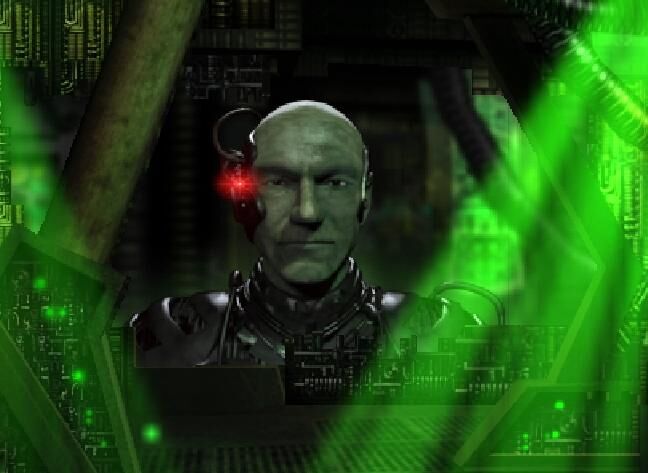
In Star Trek: Armada, set in 2376, a new Locutus of Borg was created by the Borg that had captured a Dominion cloning facility. This Locutus led an attack upon the Federation and the Klingon and Romulan empires in an attempt to gain an Omega particle, resulting in the assimilation of Spock (who was on his way to a Romulan-Klingon peace conference) and the conquest of Earth. However, aided by the USS Premonition, a time-traveling ship from the future under the command of Captain Thaddius Deming, the USS Enterprise-E was able to undo this Borg victory by going back in time to intercept the Borg fleet sent to assimilate Spock, and the Locutus clone was destroyed after a brief confrontation with the original Picard.
In Star Trek: Legacy, set in 2380, the assimilated Vulcan T'urell, who considered herself a Borg Queen, referred to Picard as "Locutus", much in the way the Borg Queen of 2373 also addressed Picard.
In the novel Resistance, set in 2380, Picard became Locutus once again in an attempt to defeat the Borg Queen. After having defeated the Queen by re-altering her into a normal drone, Dr. Crusher was able to restore the captain to his normal self.
In the novel Headlong Flight, the Enterprise-E of 2386 encounters a version of the Enterprise-D from 2367, in a world where Data and Shelby attempted to use Locutus to transmit the 'sleep' command to the Borg while still on the cube, with the result that Locutus was killed before he could be severed from the Collective as the ship self-destructed too quickly for them to get him out.
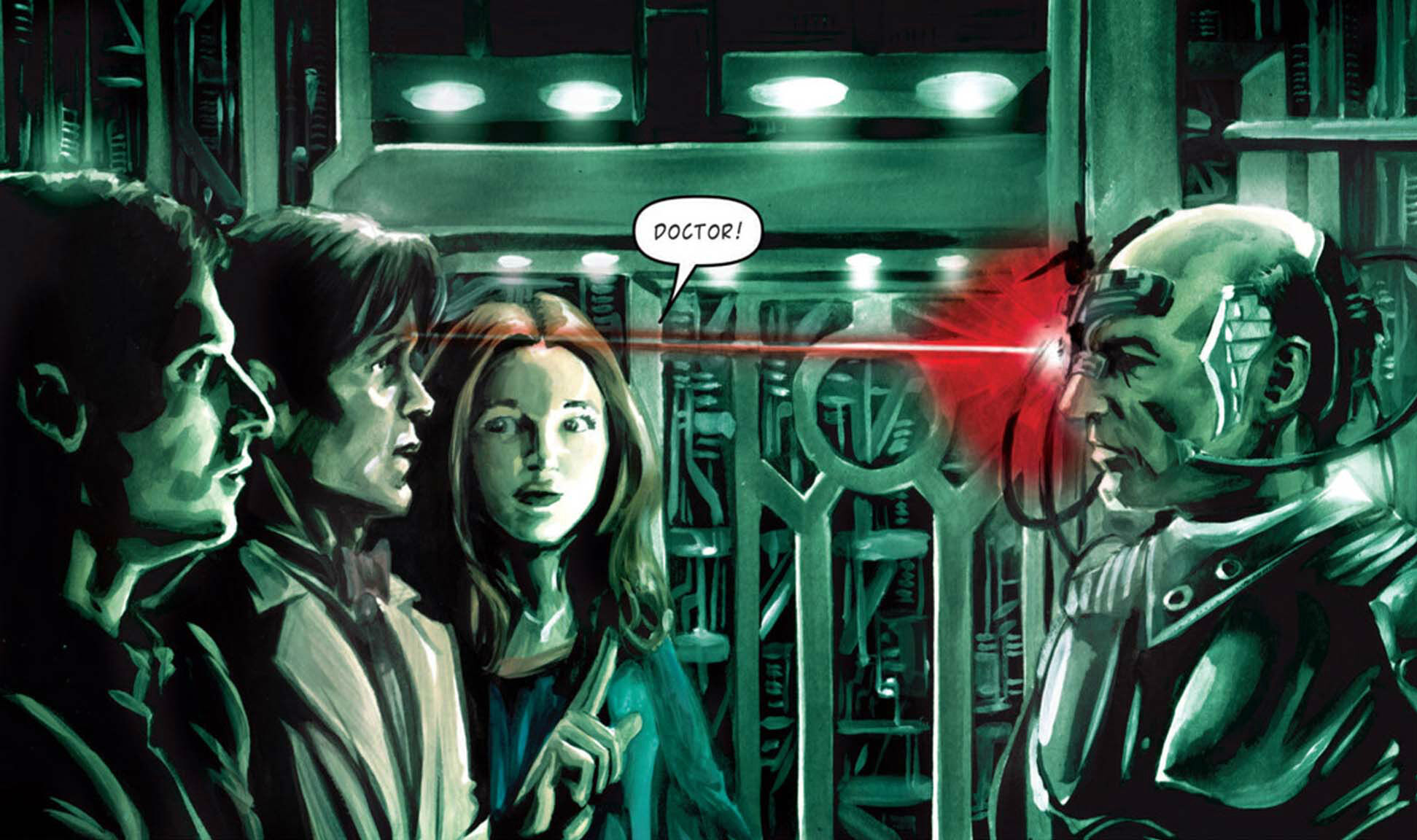
In the Doctor Who crossover comic Assimilation², Guinan explains to the Eleventh Doctor about Picard's past with the Borg and how they assimilated him into becoming Locutus and used his knowledge of Starfleet tactics at Wolf 359 as the reason why he refuses to help the Borg defeat the Doctor's enemies, the Cybermen. After convincing Picard of the threat posed by the Cybermen, the Doctor and his companions Amy Pond and Rory Williams take the TARDIS back in time to the Battle of Wolf 359 to recover a copy of the Borg central archive from the Borg cube during the battle after the present version is deleted by the Cybermen. On board the cube, they encounter Captain Picard assimilated into the Borg Collective as Locutus, but he ignores them as they proceed through the Borg ship to a computer terminal where the Doctor copies the executive libraries, as Locutus, like all Borg, doesn't register them as a threat so long as they do nothing threatening to the ship.
External links
- Locutus at Memory Beta, the wiki for licensed Star Trek works]